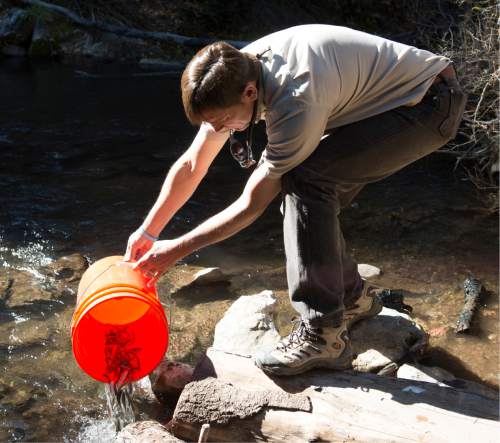This is an archived article that was published on sltrib.com in 2016, and information in the article may be outdated. It is provided only for personal research purposes and may not be reprinted.
A small 100-year-old concrete dam is coming down in Mill Creek as public land managers continue working to restore natural stream function in one of Salt Lake County's most popular recreation canyons.
The dam removal is part of a larger project that includes extirpating all the canyon's fish in three stages and replacing them with Bonneville cutthroat trout and other native species.
On Tuesday, the Utah Division of Wildlife Resources completed the final application of fish-specific poison to the creek in the lower reaches of the canyon — from the dam to the canyon's mouth, where a weir prevents fish from migrating upstream and establishing unwanted populations of nonnative trout.
For a century, the little dam near Log Haven restaurant disrupted the creek's flow. It was built to shunt water into a pipeline that delivered it to a hydropower generator down the canyon.
Over the next two months, the 1,000 feet of boardwalk along the creek above the dam will be closed to the public while crews take out the dam and reshape the stream channel above it.
This phase includes piping the creek around the project area and digging out the sediment that has settled behind the dam so it won't be flushed downstream, according to Paul Cowley, a planning officer with the Uinta-Wasatch-Cache National Forest. Suspended sediment can suffocate fish and degrade spawning habitat as it settles into the stream bottom.
"They are looking at dewatering this section next Tuesday," Cowley said, "so we aren't putting much sediment into the water column. We will haul the sediment [out of the] forest."
The project also upgraded man-made stream features to make them friendly to fish. For example, the forest replaced six culverts with larger ones to improve fish passage at those spots where the road crosses the creek. Three years ago, a footbridge at Elbow Fork was removed. This bridge marked the boundary between upper and middle stretches of the cutthroat-restoration project. The dam slated for removal is the barrier separating the middle and lower stretches.
The DWR has stocked the upper two stretches with cutthroat, and some of the fish passed over the dam; they were among the nonnative rainbows and browns that were extirpated earlier this week. The goal for the project, when work is complete, is that the entire Mill Creek drainage will be a haven for fish species that populated Wasatch streams when the pioneers arrived. Various subspecies of cutthroat have been considered for listing under the Endangered Species Act because they have been displaced by trout species and hybridized with rainbow trout.
Projects that re-establish isolated populations of pure-strain cutthroats helped keep Bonneville and other subspecies off the threatened list.
Soon after the dam is removed, between mid-October and mid-November, the DWR will stock the lower stretch with 9,000 hatchery-raised cutthroat, as well as native fish such as mountain sucker and long-nose dace, according to DWR aquatics manager Mike Slater. These nonsport fish will be relocated from Little Cottonwood Creek.
"They [cutthroat trout] should be spawning in the upper reaches early next year," Slater said. "We will monitor, and if it's necessary to add more fish, we will add more fish."
Brian Maffly covers public lands for The Salt Lake Tribune. Maffly can be reached at bmaffly@sltrib.com or 801-257-8713.
Twitter: @brianmaffly









